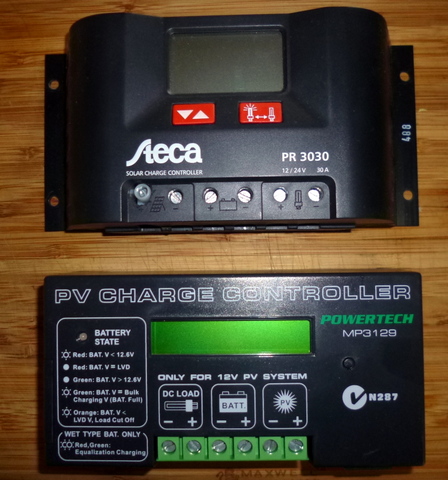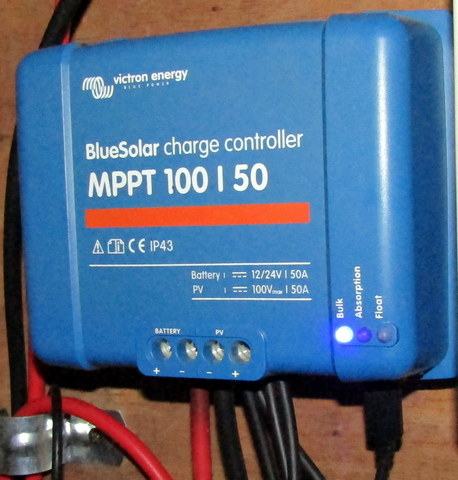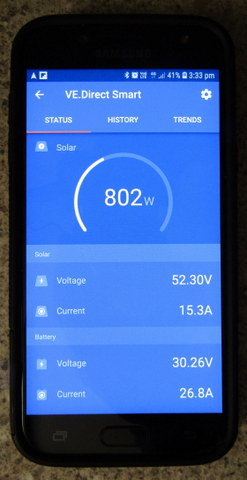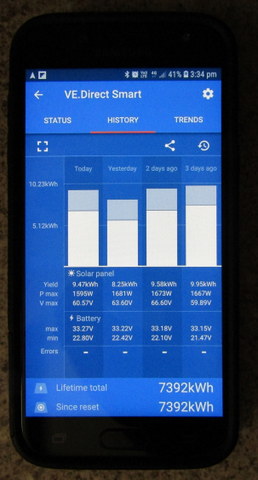To get the best out of an off grid system there needs to be some form of charge controller or regulator between the energy source (in our case, solar panels) and the energy storage, in our case nickel/iron batteries. The original solar/lead acid battery system I had put in years ago did not have a regulator originally, because I had read that charging at a rate less than 10% of the battery storage capacity meant you didn’t need one. In practice it turned out that not having a regulator resulted in reducing the battery life by over 50% and this was a pretty basic, low tech system. In the newer more high tech off grid power systems having an appropriate regulator is even more critical.
For my previous systems I had used regulators which operated as Pulse Width Modulators (PWMs). They work by sensing the battery voltage, then switching the voltage coming out of the solar panels off and on, and varying the ‘on’ and ‘off’ cycles of charging so that the battery gets charged effectively without overcharging and wrecking the batteries. They also prevent charge being lost from the batteries by power being fed back to the solar panels at night, although some panels do have diodes in place to prevent this too.
The MPPT (or Maximum Power Point Tracker). Rather than switching voltage off and on uses algorithms to constantly adjust itself so that the voltage output from the panels is constantly at the optimum required to charge the batteries. Due to the fact that MPPTs are more efficient at extracting power from the solar panels, they provide improved power harvesting low light/overcast situations.
Certainly our new off grid system is more productive on cloudy days than our original PWM regulated system. There are other differences between systems also but this does seem to be a critical one.
The MPPT we installed is a Victron Energy BlueSolar Charge controller MPPT 50/100 and the way it is configured it will accept up to a maximum 50amps from the panels at 24 volts. As we are up to (and at times a bit over) that from the existing panels, if we want to install more panels we would need another MPPT.
All outputs from the three arrays of solar panels (Front roof, rear roof and garage roof) are all run through the single MPPT and while I have had people comment that it would be more efficient to have a separate MPPT for each panel array, the current system works for us.
As the batteries are charged by the panels through the MPPT, they go through three different states which are managed by the MPPT –
Bulk – This is the first state, which starts up when the sun first hits our panels, and when the batteries are less than 80% full, allowing the panels to feed in as many amps as possible thus charging the batteries quickly.
Absorption – depending on the voltage this is set for, usually when the batteries are 80% - 90% full, the batteries remain at a pre-programmed voltage (which will vary depending on the type of batteries used) with the amperage being provided to the batteries slowly dropping as the batteries fill.
Float – at this point the batteries are fully charged, as read against the pre-set voltage and the amperage fed into the batteries becomes a trickle, set to maintain that pre-set voltage.
Our MPPT has three lights in the lower Right hand corner, showing whether the batteries are in the bulk, absorption or float state.
There is another term of interest here – Equalisation charge – This is where a pre-set overcharge is fed into the batteries on a regular basis (automatically or manually) which removes a build-up of sulphate on the batteries, improving battery life. This is also managed through the MPPT.
Our MPPT is set up so that we can monitor the system from inside the house (all the solar electronics being in the garage) to an app installed on our phones but it can only be read up to about 15 metres away from the MPPT and on one phone at a time.
There are three screens on the app providing data on how the system is operating –
Status – real time readings of solar charging wattage, current and voltage, and battery voltage, current and charging state.
History – Daily kilowatt/hour total for today and the last 30 days, maximum solar current and voltage for each day and maximum and minimum battery voltage for each day.
Trends – real time graphs of what is happening in the system over time for two of the following: solar current, solar voltage, solar power, battery voltage and battery current.
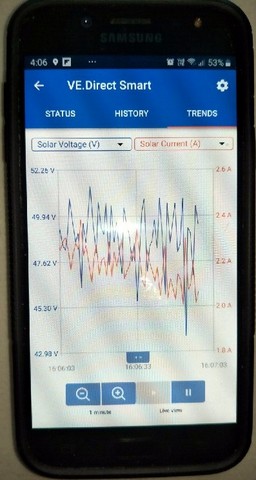
The MPPT has been operating pretty flawlessly for 4 years. There was a bit of an issue about 12 months ago when it appeared to have stopped working. I was able to get a replacement to trial within a couple of days, but it showed the same symptoms as the original. The problem turned out to be a burned out switch, the full story of which is here.
It is important to have the right gear to control and monitor the operation of your off grid energy system and we have found the MPPT which works well for us.



